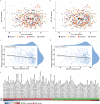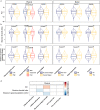Health-related quality of life is linked to the gut microbiome in kidney transplant recipients
- PMID: 38042820
- PMCID: PMC10693618
- DOI: 10.1038/s41467-023-43431-8
Health-related quality of life is linked to the gut microbiome in kidney transplant recipients
Abstract
Kidney transplant recipients (KTR) have impaired health-related quality of life (HRQoL) and suffer from intestinal dysbiosis. Increasing evidence shows that gut health and HRQoL are tightly related in the general population. Here, we investigate the association between the gut microbiome and HRQoL in KTR, using metagenomic sequencing data from fecal samples collected from 507 KTR. Multiple bacterial species are associated with lower HRQoL, many of which have previously been associated with adverse health conditions. Gut microbiome distance to the general population is highest among KTR with an impaired physical HRQoL (R = -0.20, P = 2.3 × 10-65) and mental HRQoL (R = -0.14, P = 1.3 × 10-3). Physical and mental HRQoL explain a significant part of variance in the gut microbiome (R2 = 0.58%, FDR = 5.43 × 10-4 and R2 = 0.37%, FDR = 1.38 × 10-3, respectively). Additionally, multiple metabolic and neuroactive pathways (gut brain modules) are associated with lower HRQoL. While the observational design of our study does not allow us to analyze causality, we provide a comprehensive overview of the associations between the gut microbiome and HRQoL while controlling for confounders.
© 2023. The Author(s).
Conflict of interest statement
The authors declare no competing interests.
Figures




References
-
- Akpinar O. The gut-brain axis: interactions between microbiota and nervous systems. J. Cell. Neurosci. Oxid. Stress. 2018;10:783–783. doi: 10.37212/jcnos.610103. - DOI
Publication types
MeSH terms
LinkOut - more resources
Full Text Sources
Medical

